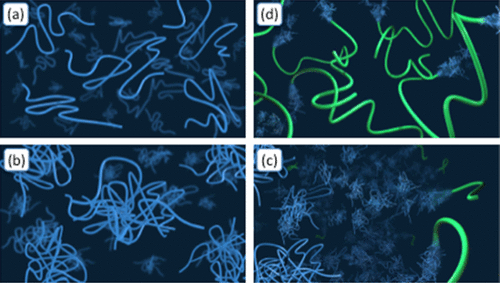当前位置:
X-MOL 学术
›
Biomacromolecules
›
论文详情
Our official English website, www.x-mol.net, welcomes your feedback! (Note: you will need to create a separate account there.)
Gelation, Phase Separation, and Fibril Formation in Aqueous Hydroxypropylmethylcellulose Solutions
Biomacromolecules ( IF 6.2 ) Pub Date : 2018-02-28 00:00:00 , DOI: 10.1021/acs.biomac.7b01611 Timothy P. Lodge , Amanda L. Maxwell , Joseph R. Lott , Peter W. Schmidt , John W. McAllister , Svetlana Morozova , Frank S. Bates , Yongfu Li , Robert L. Sammler
Biomacromolecules ( IF 6.2 ) Pub Date : 2018-02-28 00:00:00 , DOI: 10.1021/acs.biomac.7b01611 Timothy P. Lodge , Amanda L. Maxwell , Joseph R. Lott , Peter W. Schmidt , John W. McAllister , Svetlana Morozova , Frank S. Bates , Yongfu Li , Robert L. Sammler

|
The thermoresponsive behavior of a hydroxypropylmethylcellulose (HPMC) sample in aqueous solutions has been studied by a powerful combination of characterization tools, including rheology, turbidimetry, cryogenic transmission electron microscopy (cryoTEM), light scattering, small-angle neutron scattering (SANS), and small-angle X-ray scattering (SAXS). Consistent with prior literature, solutions with concentrations ranging from 0.3 to 3 wt % exhibit a sharp drop in the dynamic viscoelastic moduli G′ and G″ upon heating near 57 °C. The drop in moduli is accompanied by an abrupt increase in turbidity. All the evidence is consistent with this corresponding to liquid–liquid phase separation, leading to polymer-rich droplets in a polymer-depleted matrix. Upon further heating, the moduli increase, and G′ exceeds G″, corresponding to gelation. CryoTEM in dilute solutions reveals that HPMC forms fibrils at the same temperature range where the moduli increase. SANS and SAXS confirm the appearance of fibrils over a range of concentration, and that their average diameter is ca. 18 nm; thus gelation is attributable to formation of a sample-spanning network of fibrils. These results are compared in detail with the closely related and well-studied methylcellulose (MC). The HPMC fibrils are generally shorter, more flexible, and contain more water than with MC, and the resulting gel at high temperatures has a much lower modulus. In addition to the differences in fibril structure, the key distinction between HPMC and MC is that the former undergoes liquid–liquid phase separation prior to forming fibrils and associated gelation, whereas the latter forms fibrils first. These results and their interpretation are compared with the prior literature, in light of the relatively recent discovery of the propensity of MC and HPMC to self-assemble into fibrils on heating.
中文翻译:

羟丙基甲基纤维素水溶液中的凝胶化,相分离和原纤维形成
羟丙基甲基纤维素(HPMC)样品在水溶液中的热响应行为已通过强大的表征工具组合进行了研究,包括流变学,比浊法,低温透射电子显微镜(cryoTEM),光散射,小角度中子散射(SANS)和小角X射线散射(SAXS)。与现有文献一致,浓度范围为0.3至3 wt%的溶液的动态粘弹性模量G '和G急剧下降。''在接近57°C时加热。模量的下降伴随着浊度的突然增加。所有证据都与此相符,这与液相分离有关,从而导致聚合物贫化的基质中富含聚合物的液滴。进一步加热,模量增加,G '超过G'',对应于凝胶化。稀溶液中的CryoTEM显示,HPMC在模量增加的相同温度范围内形成原纤维。SANS和SAXS证实了在一定浓度范围内的原纤维外观,并且它们的平均直径为。18纳米; 因此,凝胶化可归因于原纤维跨样品网络的形成。将这些结果与密切相关且经过充分研究的甲基纤维素(MC)进行了详细比较。与MC相比,HPMC的原纤维通常更短,更柔韧并且包含更多的水,并且在高温下所得的凝胶具有低得多的模量。除了原纤维结构的差异外,HPMC和MC的主要区别在于,前者在形成原纤维和相关的凝胶化之前先进行了液相液相分离,而后者则首先形成了原纤维。
更新日期:2018-02-28
中文翻译:

羟丙基甲基纤维素水溶液中的凝胶化,相分离和原纤维形成
羟丙基甲基纤维素(HPMC)样品在水溶液中的热响应行为已通过强大的表征工具组合进行了研究,包括流变学,比浊法,低温透射电子显微镜(cryoTEM),光散射,小角度中子散射(SANS)和小角X射线散射(SAXS)。与现有文献一致,浓度范围为0.3至3 wt%的溶液的动态粘弹性模量G '和G急剧下降。''在接近57°C时加热。模量的下降伴随着浊度的突然增加。所有证据都与此相符,这与液相分离有关,从而导致聚合物贫化的基质中富含聚合物的液滴。进一步加热,模量增加,G '超过G'',对应于凝胶化。稀溶液中的CryoTEM显示,HPMC在模量增加的相同温度范围内形成原纤维。SANS和SAXS证实了在一定浓度范围内的原纤维外观,并且它们的平均直径为。18纳米; 因此,凝胶化可归因于原纤维跨样品网络的形成。将这些结果与密切相关且经过充分研究的甲基纤维素(MC)进行了详细比较。与MC相比,HPMC的原纤维通常更短,更柔韧并且包含更多的水,并且在高温下所得的凝胶具有低得多的模量。除了原纤维结构的差异外,HPMC和MC的主要区别在于,前者在形成原纤维和相关的凝胶化之前先进行了液相液相分离,而后者则首先形成了原纤维。



























 京公网安备 11010802027423号
京公网安备 11010802027423号